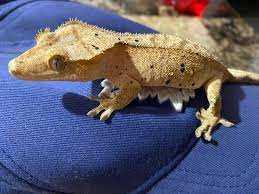
The gecko is a fascinating creature that never fails to capture our attention with its unique features. One particular gecko species that stands out from the rest is the brindle crested gecko. With its striking colors and distinctive patterns, it is truly a sight to behold.
One of the most remarkable characteristics of the brindle crested gecko is its stunning coloration. It comes in a wide range of vibrant shades, including oranges, yellows, reds, and even blues. The colors are often accompanied by intricate patterns that add to its overall appeal.
In addition to its eye-catching colors, the brindle crested gecko is also known for its distinct crests. These crests, located above its eyes and running along the sides of its body, give it a unique and regal appearance. They serve both a functional and aesthetic purpose, aiding in communication and display.
If you are looking to add a unique and colorful reptile to your collection, the brindle crested gecko is definitely worth considering. With its captivating colors, intricate patterns, and distinctive crests, it is sure to be a standout in any reptile enclosure.
What is a Brindle Crested Gecko?
A Brindle Crested Gecko is a unique and colorful reptile that belongs to the species Correlophus ciliatus. This species of gecko is native to New Caledonia, a group of islands located in the Pacific Ocean. The Brindle Crested Gecko is known for its distinctive crests on its head and along its back, which give it its name. It has a slender body and a prehensile tail, which it uses to grip onto branches and other surfaces.
Brindle Crested Geckos are primarily arboreal, meaning they spend most of their time in trees and vegetation. They have specially adapted feet with lamellae, which allow them to grip onto surfaces and climb with ease. In the wild, they can be found in the forests and humid areas of New Caledonia, where they feed on insects and small fruits.
As pets, Brindle Crested Geckos have become increasingly popular due to their unique appearance, ease of care, and docile nature. They are relatively low-maintenance reptiles, making them suitable for beginners and experienced reptile enthusiasts alike. They can be kept in small enclosures with proper humidity, temperature, and UVB lighting. Their diet includes a variety of insects and fruit-based diets.
Native Habitat of the Brindle Crested Gecko
The Brindle Crested Gecko is a reptile native to the forests of New Caledonia, a group of islands located in the southwest Pacific Ocean. These geckos are specifically found in the southern parts of the main island and on the small surrounding islands.
Forest Canopy Dwellers
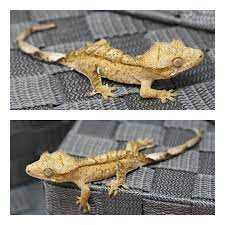
Within their natural habitat, these geckos are commonly found hiding among the lush foliage, blending in with their surroundings due to their unique coloration. This provides them with a level of camouflage, protecting them from predators such as birds and larger reptiles.
Tropical Climate
The forest floor is typically covered in fallen leaves, branches, and decaying organic matter, creating a diverse ecosystem for the geckos to inhabit. This environment provides them with an abundant source of food, including insects, fruit, and nectar from flowers.
The Brindle Crested Gecko has adapted to this specific habitat over time, making it crucial for their well-being in captivity to replicate these environmental conditions as closely as possible.
Conservation Efforts
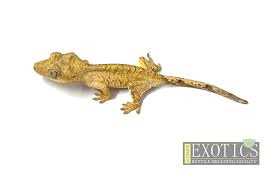
The Brindle Crested Gecko, like many other reptiles, faces threats in its native habitat due to deforestation and illegal collection for the pet trade. Increased awareness and conservation efforts are crucial to protect these unique creatures and ensure their survival in the wild.
Zoological institutions and dedicated hobbyists are working together to breed these geckos in captivity, reducing the demand for wild-caught specimens. Through responsible ownership, education, and conservation initiatives, it is possible to help preserve the natural habitat of the Brindle Crested Gecko for future generations.
Physical Characteristics of the Brindle Crested Gecko
The Brindle Crested Gecko is a unique reptile known for its distinctive physical characteristics. These geckos have a brindle pattern, which is a mixture of different colors that create a marbled or streaked appearance. This pattern can vary greatly from gecko to gecko, with some having more pronounced brindle markings than others.
One of the most striking features of the Brindle Crested Gecko is its crested head. These geckos have a row of fringed crests that run from the top of their head down to the base of their tail. These crests give them a unique and regal appearance.
The body of the Brindle Crested Gecko is relatively small and compact, measuring around 6-8 inches in length. They have a stout build and a slightly flattened tail. Their toes are equipped with adhesive pads that allow them to grip onto surfaces and climb with ease.
Another interesting characteristic of the Brindle Crested Gecko is its large, round eyes. These geckos have vertically elliptical pupils that give them excellent vision, especially in low-light conditions. Their eyes come in various colors, ranging from deep red to bright yellow.
In terms of coloration, the Brindle Crested Gecko can display a wide range of hues. They can be found in shades of brown, orange, red, green, and even blue. The brindle pattern adds an extra layer of complexity and visual interest to their overall coloration.
Overall, the Brindle Crested Gecko is a visually stunning reptile with a unique combination of physical characteristics. Its brindle pattern, crested head, and vibrant coloration make it a sought-after species among reptile enthusiasts.
Unique Coloration of the Brindle Crested Gecko
The brindle crested gecko is known for its unique and striking coloration, which sets it apart from other gecko species. The term “brindle” refers to the pattern of irregular dark lines and spots that are found on the gecko’s body. This pattern creates a beautiful and intricate mosaic-like design that varies from gecko to gecko.
This coloration is highly coveted by reptile enthusiasts and collectors, as it adds an element of rarity and beauty to the gecko’s appearance. The brindle pattern can manifest in a variety of colors, including shades of brown, orange, red, and even black. The patterns can be symmetrical or asymmetrical, creating a visually stunning effect.
Causes of Brindle Coloration
The exact cause of the brindle coloration in crested geckos is not fully understood by scientists. It is believed to be a result of genetic mutations that affect the pigmentation of the gecko’s skin. These mutations can alter the distribution and intensity of melanin, the pigment responsible for the gecko’s coloration.
Adaptation and Camouflage
The brindle coloration of the crested gecko serves several purposes in its natural habitat. In its native rainforest environment, the gecko uses its coloration as a form of camouflage, allowing it to blend in with its surroundings and avoid detection by predators.
The irregular brindle pattern helps to break up the gecko’s outline, making it less visible against the bark of trees and the forest floor. This adaptation provides the gecko with an added layer of protection, allowing it to remain hidden from potential threats.
Differences between Male and Female Brindle Crested Geckos
Physical Characteristics:
One of the most reliable ways to determine the sex of a brindle crested gecko is by looking at their physical features. Males tend to have larger heads, wider bodies, and longer tails compared to females. They also have prominent hemipenal bulges located at the base of their tails, which are used for reproduction.
Another noticeable difference is the presence of pre-anal pores. These are small, raised bumps found on the underside of the gecko, near the vent. Males have more pronounced and larger pre-anal pores compared to females. These pores release a waxy substance that helps in identifying the gender of the gecko.
Behavior:
Males are typically more territorial and aggressive than females. During breeding season, males may display dominance behaviors, such as tail waving, head bobbing, and vocalizations, to attract female mates and establish their dominance over other males.
Females, on the other hand, tend to be more docile and less active. They may display submissive behaviors, such as tail curling and hiding, when approached by a male during breeding season.
Table:
| Characteristic | Male Brindle Crested Gecko | Female Brindle Crested Gecko |
|---|---|---|
| Head size | Larger | Smaller |
| Body width | Wider | Narrower |
| Tail length | Longer | Shorter |
| Hemipenal bulges | Present | Absent |
| Pre-anal pores | Pronounced and larger | Less pronounced and smaller |
Diet and Feeding Habits of the Brindle Crested Gecko
The diet and feeding habits of the brindle crested gecko are crucial to their overall health and well-being. As omnivores, these geckos have specific dietary needs that must be met in order to thrive.
In addition to insects, brindle crested geckos also enjoy eating fruits. Fresh fruits such as mashed bananas, papaya, mango, and figs can be offered as occasional treats. It is essential to remove any uneaten fruits from the enclosure to prevent spoilage and the attraction of pests.
Commercially prepared powdered diets specifically formulated for crested geckos are also a convenient and nutritious option. These diets usually come in the form of a powder that can be mixed with water to create a paste or gel. They contain a balanced blend of proteins, fruits, and vitamins, providing a complete and well-rounded diet for the gecko.
When feeding the gecko, it is recommended to provide a shallow dish of water for them to drink from. The water should be changed regularly to ensure cleanliness. Additionally, misting the enclosure with water is crucial to maintain proper humidity levels, as brindle crested geckos obtain a significant amount of their water from licking droplets off leaves and surfaces.
Housing and Care Requirements for Brindle Crested Geckos
Habitat Setup
The terrarium should be decorated with branches, vines, and foliage to mimic their natural habitat. Live or artificial plants can be used to create hiding spots and climbing opportunities. It is essential to provide a few hiding places to make your gecko feel secure.
Temperature and Lighting
Humidity and Hydration
One of the most crucial aspects of caring for a brindle crested gecko is maintaining the correct humidity levels in their enclosure. These geckos require a humidity level of 50-70%. To achieve this, misting the enclosure once or twice daily with dechlorinated water is necessary. You can also use a hygrometer to monitor the humidity levels.
Diet
Overall, providing a suitable habitat and meeting the specific care requirements for brindle crested geckos is essential for their well-being. By following these guidelines, you can ensure that your gecko remains healthy and happy in captivity.
Handling and Taming the Brindle Crested Gecko
Support the gecko’s body with both hands, ensuring that they feel secure. Avoid grasping or squeezing the gecko, as this can cause stress or injury. It’s also important to wash your hands before and after handling to avoid transferring any bacteria or chemicals to the gecko’s sensitive skin.
Taming a brindle crested gecko involves gradually building trust and familiarity with the gecko. Spend time near their enclosure, talking softly and offering treats, such as small insects or fruit. This will help the gecko become more comfortable with your presence.
Once the gecko is comfortable being handled, you can start gently stroking their body and head. Avoid touching their tail, as it is fragile and can easily break off. If the gecko shows signs of stress, such as tail waving or hissing, it’s best to give them some space and try again later.
Breeding and Reproduction of the Brindle Crested Gecko
Brindle Crested Geckos have become increasingly popular in the reptile community, and many enthusiasts are interested in breeding these unique and colorful reptiles. Breeding Brindle Crested Geckos requires careful planning and attention to detail, but with the right knowledge and preparation, it can be a rewarding experience.
During the breeding season, which typically occurs from spring to early summer, Brindle Crested Geckos will become more active and show signs of increased sexual activity. The male gecko will develop prominent hemipenal bulges at the base of the tail, while the female will develop noticeable egg follicles in her abdomen.
In order to initiate breeding, it is essential to provide the geckos with the appropriate environmental conditions. This includes maintaining a temperature gradient within their enclosure, with a warm side ranging from 78-82°F (25-28°C) and a cooler side around 72-76°F (22-24°C). It is also important to provide a humid environment, with humidity levels ranging from 50-70%. This can be achieved by misting the enclosure with water or using a reptile fogger.
Common Health Issues and Concerns for Brindle Crested Geckos
The brindle crested gecko, like any other reptile, is susceptible to certain health issues and concerns that owners should be aware of. While these issues are not exclusive to brindle crested geckos, they are important to address and monitor to ensure the well-being of your pet.
Metabolic Bone Disease:
One of the most common health issues in crested geckos is metabolic bone disease (MBD). MBD occurs when the gecko’s body does not get enough calcium and vitamin D3, leading to weakened bones. This can be caused by a lack of proper nutrition or inadequate exposure to UVB lighting. To prevent MBD, it is essential to provide a balanced diet that includes calcium and vitamin D3 supplementation, as well as proper UVB lighting in the gecko’s enclosure.
Respiratory Infections:
Brindle crested geckos can also be prone to respiratory infections, which can be caused by low humidity levels or poor ventilation in their enclosure. Symptoms of a respiratory infection may include wheezing, difficulty breathing, and nasal discharge. If you notice any of these symptoms, it is crucial to consult a veterinarian who specializes in reptile care for proper diagnosis and treatment.
Stuck Shed:
Impaction:
Parasites:
Parasites, such as mites and intestinal worms, can also affect the health of brindle crested geckos. Regular veterinary check-ups and fecal exams can help identify and treat any parasite infestations. Additionally, practicing good hygiene and regularly cleaning and disinfecting the gecko’s enclosure can help prevent parasite infestations.
Where to Buy a Brindle Crested Gecko
If you’re interested in owning a Brindle Crested Gecko, there are several places where you can purchase one. One option is to visit a local exotic pet store or reptile show. These establishments often have a variety of geckos available, including Brindle Crested Geckos. This allows you to see the geckos in person and ask any questions you may have to the knowledgeable staff.
Before bringing your new Brindle Crested Gecko home, make sure you have the proper setup and supplies. This includes a suitable enclosure, heating and lighting equipment, and a variety of hiding spots and climbing structures. Additionally, be prepared to provide a nutritious diet and regular veterinary care for your gecko.
Overall, owning a Brindle Crested Gecko can be a rewarding and unique experience. If you do your research and provide proper care, you’ll have a beautiful and fascinating pet that will bring joy to your life for years to come.
Tips for Caring for a Brindle Crested Gecko as a Pet
1. Housing
Provide a suitable enclosure for your brindle crested gecko. A glass terrarium or a plastic tub with proper ventilation is ideal. Make sure the enclosure has enough space for climbing and hiding, with branches, plants, and secure hiding spots.
2. Temperature and Humidity
Maintain a temperature gradient in the enclosure, with a warm side between 75-80°F (24-27°C) and a cooler side around 70-75°F (21-24°C). The humidity level should be around 50-70%, which can be achieved by misting the enclosure daily and using a hygrometer to monitor humidity levels.
3. Lighting
A proper lighting setup is essential for your gecko’s health. Use a UVB bulb to provide essential UVB rays for proper calcium absorption. Additionally, provide a heat source like an overhead heat lamp or heat mat to maintain the desired temperature gradient.
4. Diet
Feed your brindle crested gecko a balanced diet of commercially available crested gecko diet, insects, and fruits. Offer a variety of food options to ensure they receive all the necessary nutrients. Dust insects with calcium powder before feeding to ensure proper calcium intake.
5. Water
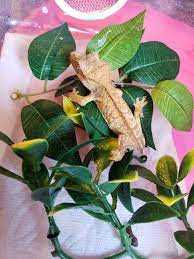
Provide clean, fresh water in a shallow dish. Replace the water daily to ensure your gecko stays hydrated. You can also mist the enclosure to provide additional hydration and simulate natural conditions.
6. Handling and Socialization
Handle your brindle crested gecko gently and with care. Avoid excessive handling, especially during shedding or when they appear stressed. Allow your gecko to adjust to their new environment before attempting to handle them extensively.
7. Health Check-ups
Regularly monitor your gecko for any signs of illness, such as changes in appetite, weight loss, or abnormal behavior. If you notice any concerns, consult a reptile veterinarian experienced in treating crested geckos.
Remember: Proper research, observation, and a commitment to providing the best care possible are essential for the well-being of your brindle crested gecko. By following these tips, you can create a suitable and enriching environment for your gecko to thrive as a pet.
Disclaimer: It’s always recommended to consult with a qualified reptile veterinarian or expert for personalized advice on caring for your brindle crested gecko.
Interesting Facts about the Brindle Crested Gecko
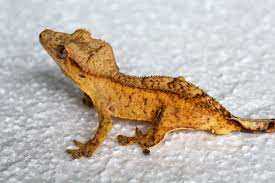
The Brindle Crested Gecko is a fascinating reptile with several interesting facts that make it a unique pet choice for reptile enthusiasts.
1. Nocturnal Behavior
Unlike many other reptiles, the Brindle Crested Gecko is primarily nocturnal, meaning it is most active during the night. This makes it an excellent pet for individuals who work during the day and are able to interact with their pet in the evenings.
2. Ability to Climb Vertically
The Brindle Crested Gecko has incredible climbing abilities, thanks to its specialized feet. It has sticky toe pads that allow it to effortlessly climb and cling to vertical surfaces, such as tree barks and glass enclosures.
3. Vocalizations
While many reptiles are silent creatures, the Brindle Crested Gecko is known for its unique vocalizations. It can produce various sounds, including chirps, clicks, and barks. These vocalizations are used for communication and territorial purposes.
4. Ability to Regenerate Tail
5. Lack of Eyelids
6. Long Lifespan
The Brindle Crested Gecko can live for a relatively long time in captivity, with an average lifespan of 15 to 20 years. With proper care and a balanced diet, these geckos can become long-term companions for their owners.
Overall, the Brindle Crested Gecko is a fascinating reptile with unique features and behaviors that make it an interesting and rewarding pet. Its nocturnal nature, climbing abilities, vocalizations, regeneration capabilities, lack of eyelids, and long lifespan all contribute to its appeal as a pet choice.

I’m Lena Adams—a product of an unconventional upbringing in the African wilderness. My father, a daring explorer of African wildlife, sparked my fascination with reptiles, a passion that intertwined with the tragic loss of my mother during an expedition, leaving an indelible mark on my life. Driven to understand the creatures that captivated my parents, I embarked on my journey, sharing insights about reptiles, frogs, and lizards on my website. Through my explorations and conservation efforts, I honour my family’s legacy while seeking connections—to the creatures, nature, and the mother whose presence I yearn to understand.
